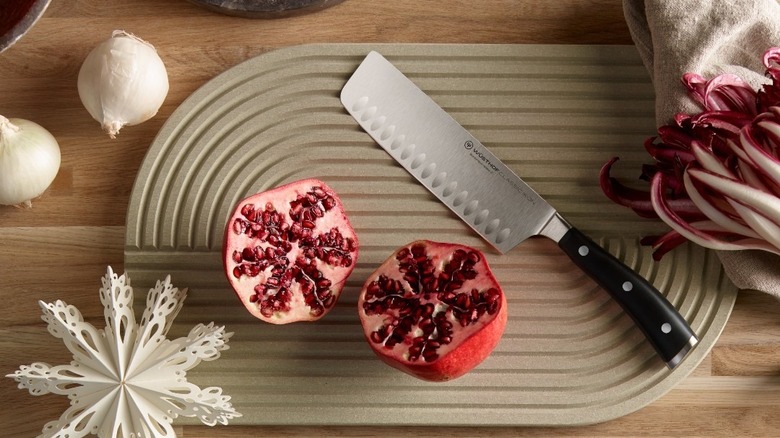Ree Drummond's Go-To Chef's Knife Is A Versatile Classic
One could argue that a knife is the most valuable tool in a chef's arsenal, which is perhaps why many have a favorite blade that they wouldn't imagine cooking without. For Giada De Laurentiis, it's a nine-inch chef's knife handmade by Coltellerie Berti in Italy that does the trick (per The Kitchn). On the flip side, Bobby Flay prefers an eight-inch one crafted in Japan by Shun.
Both Ree Drummond and Ina Garten swear by Wüsthof's blades — a Germany-based, family-run company that has been manufacturing sharp knives since 1814. But where the Barefoot Contessa also considers a chef's knife made by the company as one of four knives every cook needs, The Pioneer Woman fancies something slightly different. Her favorite? Wüsthof's nakiri knife. Drummond admitted on her website that, "A good knife is essential in the kitchen, and this one's my favorite." More importantly, she added, "It makes my heart go pitter-pat."
Wüsthof makes three seven-inch nakiri knives that range from $100 to $200. Drummond doesn't specify exactly which of these three she prefers — though one might assume that it's the Classic Hollow Edge Nakiri judging by the photo on her site. Those who follow The Pioneer Woman on Instagram might have also noticed the knife making an appearance in her reels, being used to slice everything from onions to soft and juicy peaches. But the question remains: What is a nakiri knife? Above all, will it make your heart go pitter-pat too?
What is a nakiri knife?
Nakiri (together with the fish knife deba) is one of two knives traditionally considered essential in Japan. Named after the Japanese word for leaf cutter, nakiri is fundamentally a vegetable knife. It has a flat and wide rectangular blade much like a cleaver, except it is thinner, shorter, lighter, and has a rounded tip. This design is what makes nakiri as unique as other Japanese-style chef's knives. Where most Western chef's knives have curved blades that are rocked back and forth to slice vegetables, a nakiri's long blade makes clean cuts in one go using a single downward motion. As a result, nakiri yields smooth, neat, and precise cuts that don't bruise or break ingredients jaggedly.
Besides, the nakiri is versatile. It can mince, dice, and slice greens of course, but it can also glide through just about any ingredient like butter, including fruits and boneless meats. Its long, tip-to-tail blade enables you to slice large veggies like zucchini, eggplants, and entire heads of lettuce in one fell swoop as well. Plus, the nakiri is a user-friendly knife that doesn't require much force or effort and is light enough to make delicate, controlled cuts swiftly.
The only thing that nakiri can't do is tackle hardy ingredients like pumpkins, frozen foods, crusty bread, or meat with bones. Barring these, a nakiri knife is handy enough to be used for practically everything else, which explains why it's a kitchen tool that Ree Drummond can't live without.


